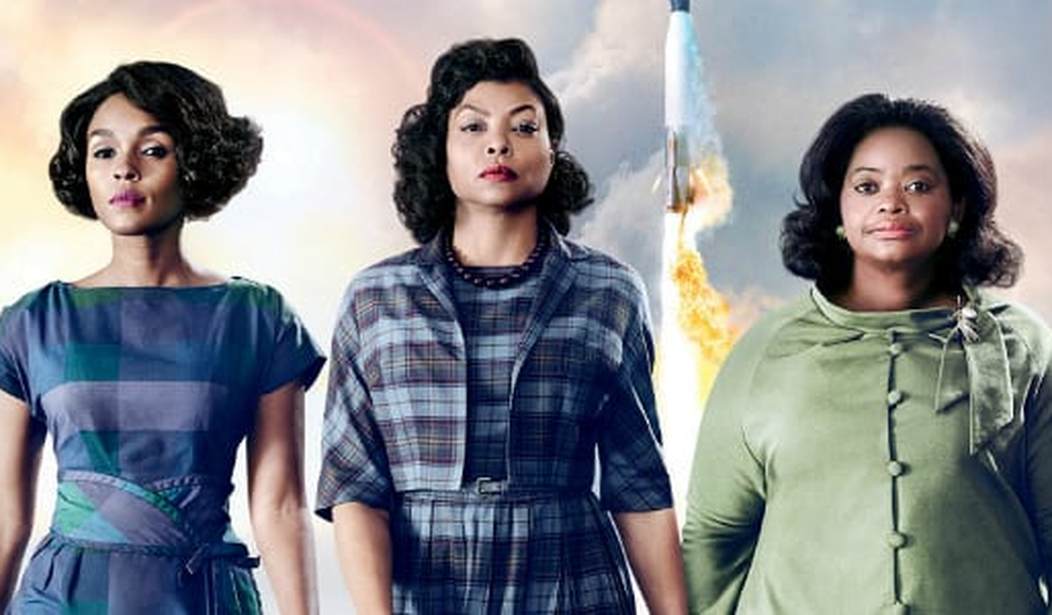I was really really enjoying Hidden Figures, the film about a trio of black female scientists whose behind the scenes efforts were important to the early space program. I was feeling the outrage the director wanted me to feel at the humiliating segregation these women had to fight against in the late 50s and early 60s as NASA raced the Soviets into space.
Then it hit me. As a preacher commended a handsome soldier for being part of the president’s enforcing of Brown v. Board of Education, I thought, “Wait. And there are still separate bathrooms at NASA labs in Virginia? In the 1960s?”
Well, no. There weren’t.
So as Hidden Figures hovers around the top spot in DVD sales on Amazon, here are four pivotal reasons to be cautious about adding it to your collection as a compelling history lesson that’s suitable for young minds.
1. NASA, like all federal agencies, was desegregated in the 1940s
Hidden Figures, the movie, is set in the Langley Memorial Aeronautical Laboratory in Hampton Va., as the United States is trying to overtake the Russians in the space race in the 1960s.
The lab is portrayed as having white and colored bathrooms, water fountains, and even coffee pots. This is outright fiction. Something like this may have been the case in 1942, but not 1962. FDR ended this, and it certainly wasn’t in full view in the Kennedy Administration.
Katherine Johnson, the real woman behind the story of the film, started working there in 1952. She says she never experienced any overt racism and talks glowingly about the team effort of NASA. Which brings us to our next point…
2. The most dramatic scene in the movie never happened
A good deal of the movie is spent building our outrage at Katherine having to run about a mile and a half through the lab in order to use the “colored only” bathroom, sometimes in the rain.
Her supervisor, the decent-white-guy-who-is-oblivious-to-the-outrageous-prejudice-all-around-him, played by Kevin Costner, finally demands to know why her bathroom breaks are so darn long, while he is working his butt off to put John Glenn into orbit.
The stand up and cheer moment of the film is Katherine’s tearful speech standing up for herself, which leads to Clueless White Guy finally noticing the separate coffee pot next to the one he uses every day, and marching across campus to physically break down the colored bathroom sign.
Stirring stuff. And completely made up.
In truth, in the 1950s, there was an informal segregation of bathrooms that Katherine Johnson was unaware of for years and just ignored when someone pointed it out to her. Mary Jackson actually did go in search of a blacks only bathroom at one point, after some giggling women made her feel unwelcome, but it was short lived.
3. Dorothy Vaughan became a manager in 1948, not 1968, and Mary Jackson petitioned the segregated city of Hampton early enough in the 1950s that she earned her degree in 1958
Another pivotal plot in the film is that of Dorothy Vaughan, who, supposedly in the 1960s, had to teach herself how to use the new IBM computer, and sneak her black co-workers in after hours to learn the machine so well that the white computer geeks had to let her run the joint because only she could run the thing effectively.
Then Dorothy led her team down the hall in slow motion like the iconic astronaut strut in The Right Stuff.
Pure fiction. Dorothy wowed her bosses with her abilities and was made the first black female manager at Langley in 1948.
And while Virginia was, indeed, a segregated state into the 1960s, it was hardly Alabama. Mary Jackson, who was encouraged by her NACA (the agency wasn’t NASA yet) supervisor to pursue her engineering degree, petitioned the city of Hampton for permission to attend school and it was granted—in the 1950s.
4. Every character who expresses racist or sexist attitudes in the film is a fictional character.
Here we get the usual excuse—the characters are composites. It’s a movie, we can’t have a bunch of minor characters cluttering up our film.
They are composites all right. Composites of writer/director Theodore Melfi’s vision of what all white professionals must have been like before they became as enlightened and sensitive as he and his modern contemporaries.
And what the heck is with John Glenn having hair? Where is the famous signature Marine crew cut?
The reaction of NASA historians and retired scientists has been pretty muted. We get all the excuses, even from the book’s author. “Well, yes, timelines had to be conflated,” we hear. “It’s a movie. If you want real history, read the book,” blah blah blah.
But, you say, I didn’t know there were black women mathematicians involved. Why was that suppressed all these years in favor of those white astronauts? Okay, how many movies have you seen about any of the people making the calculations behind the scenes at NASA? There’s a reason movies—and government publicity campaigns—are about astronauts, not astrophysicists.
Look, The Right Stuff is a great movie that had some details wrong. People in various parts of the space program didn’t appreciate Tom Wolfe’s take on everything, either. But acting like the 1960s at NASA was no different than the early 1940s in the matter of civil rights is not a detail. It’s a major distortion of American history. Director Philip Kaufman didn’t pretend Chuck Yeager was still trying to break the sound barrier in 1965.
But then, Melfi couldn’t be bothered with the details in the book Hidden Figures. Why? The movie is based on a 55-page proposal to the publisher. A glorified outline. The filmmakers’ own prejudices about America took over from there.
Fine, they didn’t have the whole book. But couldn’t they have interviewed the principals—or used Google?
Hidden Figures the movie (like the book) should have been about the black women who overcame prejudice during World War II, at the time America was fighting a racist enemy overseas and then went on to help put the United States on the moon. That’s also a great story—and it has the benefit of being true.
Or how about Katherine Johnson’s dad moving around the segregated South in the 1920s and 30s in order to get the right education for his brilliant daughter? That’s the right stuff.
For a lot more truth vs. fiction about Hidden Figures, check out History vs. Hollywood’s article on the film.









Join the conversation as a VIP Member